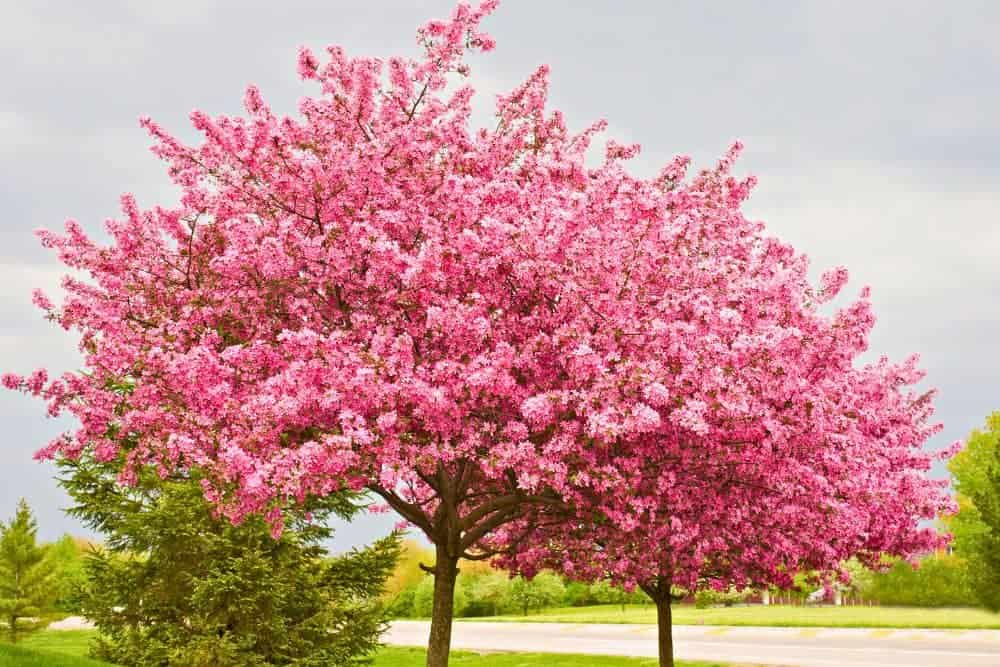Ground covers and shrubs have their charm, but nothing compares to the spectacle that flowering trees bring!
And they’re not just pretty. Flowering trees do wonders for biodiversity by luring in pollinators and feeding native wildlife.
In Australia, you won’t run out of flowering trees to choose from. There are blooms for every season, in every colour imaginable.
We’ve rounded up some of the best flowering trees in Australia, perfect for any time of the year!
Australia’s Best Flowering Trees
There’s really no single “best” flowering tree. It all depends on your local climate, space, and the colours you like.
Flowering trees have different uses, too.
Many stand out as feature trees, while some are planted along driveways. Some evergreen flowering trees can also be planted in rows to create hedges or screens.
That said, the chart below lists some of the best flowering trees in Australia, by flower colour.
Many of these are natives, so they’re adapted to local conditions and are easy to care for.
| PINK FLOWERING TREES | PURPLE FLOWERING TREES | RED FLOWERING TREES |
| Blueberry ash ‘Prima Donna’ Cape chestnut Cherry blossom Eastern redbud |
Chaste tree Jacaranda Magnolia ‘Royal Purple’ Tibouchina ‘Alstonville’ |
Christmas bush Illawarra flame tree Queensland tree waratah Red flowering gum tree |
| WHITE FLOWERING TREES | YELLOW FLOWERING TREES | VARIOUS COLOURS |
| Flowering dogwood Ivory curl tree Lemon myrtle Magnolia tree |
Golden penda Golden wattle Native frangipani Yellow kapok |
Banksia Crepe myrtle Flowering gum trees Frangipani |
Below, you’ll find the trees’ typical size, flowering season, and preferred climate, so you can pick the right one for your garden!
Trees with Pink Flowers
Pink flowering trees are a crowd pleaser. They can shine as backyard trees, out front in your garden, and even along streets.
In Australia, cherry blossom trees steal the spotlight.
But you’ll also find beauties like the blueberry ash ‘Prima Donna,’ cape chestnut, and eastern redbud.
Blueberry ash ‘Prima Donna’
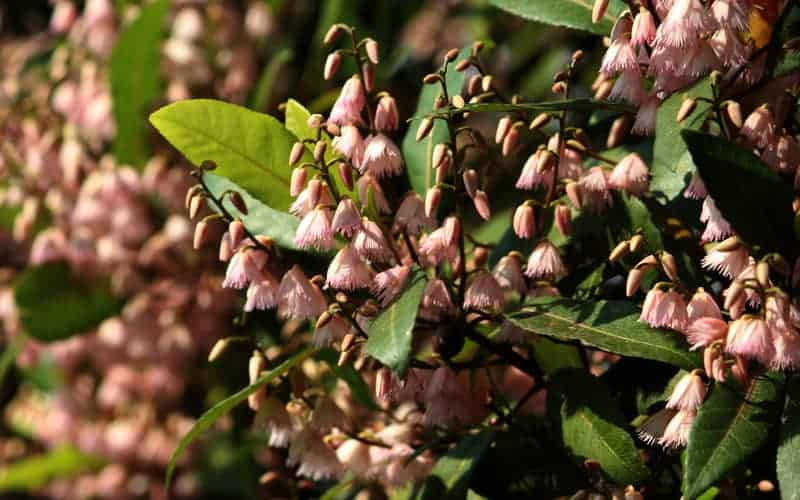
Size: 4–7m tall and 3m wide
Flowering season: Late spring to mid-summer
Ideal climate: Mediterranean, temperate, and subtropical
The blueberry ash (Elaeocarpus reticulatus) ‘Prima Donna’ is an Australian flowering tree.
This medium-sized evergreen grows narrow and upright, so it can be used to create privacy screens.
In spring to summer, the ‘Prima Donna’ bursts into clusters of soft pink, fringed flowers.
Hanging from the branches, the blooms look like a ballet tutu — hence the name ‘Prima Donna’!
The flowers later turn into blue berries, which feed seed-eating birds.
‘Prima Donnas’ are low-maintenance once established. They do well in full sun to part shade and well-draining soil.
Cape chestnut
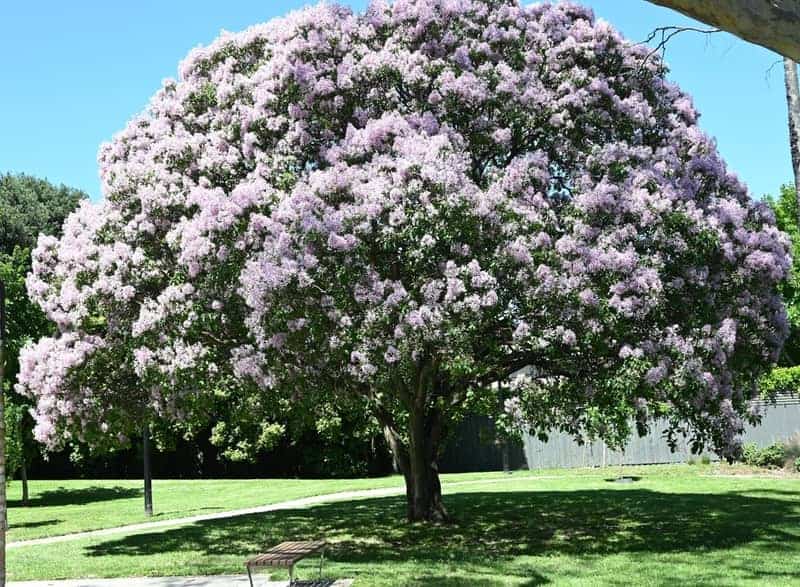
Size: 8–12m tall and wide
Flowering season: Spring to summer
Ideal climate: Subtropical and warm temperate
For a stunning visual impact in the garden, grow the cape chestnut (Calodendrum capense).
This South African native produces pink to mauve flowers with slender petals, often in spring or summer.
The blooms are lightly fragrant — many describe the scent as sweet and honey-like!
Besides the gorgeous flowers, the cape chestnut makes a lovely shade tree, thanks to its broad canopy. That’s why it’s often planted as a street tree, particularly in Melbourne and Sydney.
Depending on the climate, the C. capense can be semi-deciduous or evergreen.
In cooler areas, the leaves may drop in winter. But in warmer spots, the foliage usually stays lush year-round.
Cherry blossom
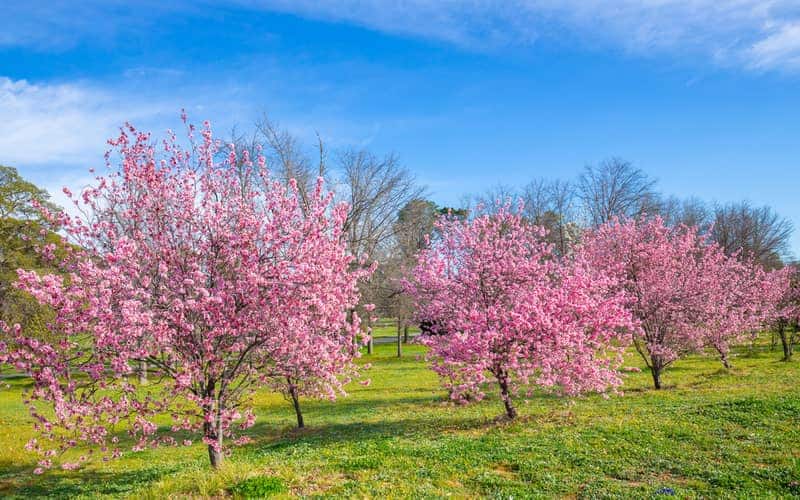
Size: 5–8m tall and 4–5m wide
Flowering season: Late winter to spring
Ideal climate: Cool climates
The cherry blossom (Prunus serrulata) is a deciduous tree native to Japan, where it’s called “sakura.”
In Japanese culture, cherry blossoms symbolise the fleeting nature of life. After all, they last just 1–2 weeks.
Even so, the flowers are exquisite! When the tree blooms, it looks like it’s wrapped in soft pink clouds from afar.
But if you look closely, you’ll see masses of delicate blossoms covering the bare branches.
A popular variety is the ‘Kanzan,’ which has fluffy, pink flowers. Another is the ‘Cheals’ Weeping Cherry, known for its graceful form.
In Australia, cherry blossom trees do best in mountainous regions like the Adelaide Hills (SA) and the Dandenong Ranges (VIC).
They can also grow in colder areas like the ACT, TAS, and parts of NSW.
Eastern redbud
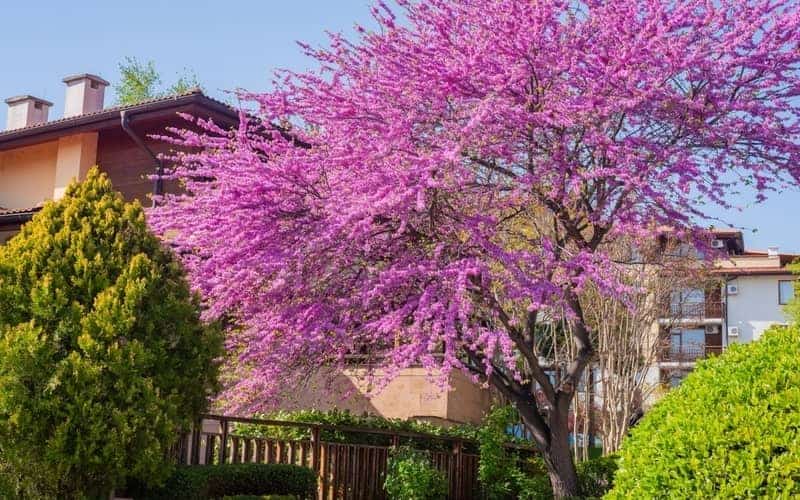
Size: 6–9 m tall and 7–10m wide
Flowering season: Spring
Climate: Temperate
The eastern redbud (Cercis canadensis) is a popular specimen tree.
It’s widely loved for its rosy pink, pea-shaped flowers that appear in early spring!
The blooms show up just before the leaves, making them stand out even more.
This tree also features attractive foliage. The leaves are dark green through the warmer months. Then, they turn yellow in autumn before dropping in winter.
C. canadensis grows best in temperate climates, as it needs a cold period to produce many flowers.
It will do well in full sun or part shade, as long as it’s planted in rich, well-draining soil.
Once established, the eastern redbud is drought-tolerant and easy to care for.
Trees with Purple Flowers
Purple blossoms can bring elegance to any space, as the colour has long been linked to luxury.
While the jacaranda is the most famous purple flowering tree in Australia, there are other options, too.
These include the chaste tree, magnolia ‘Royal Purple,’ and tibouchina ‘Alstonville.’
Chaste tree
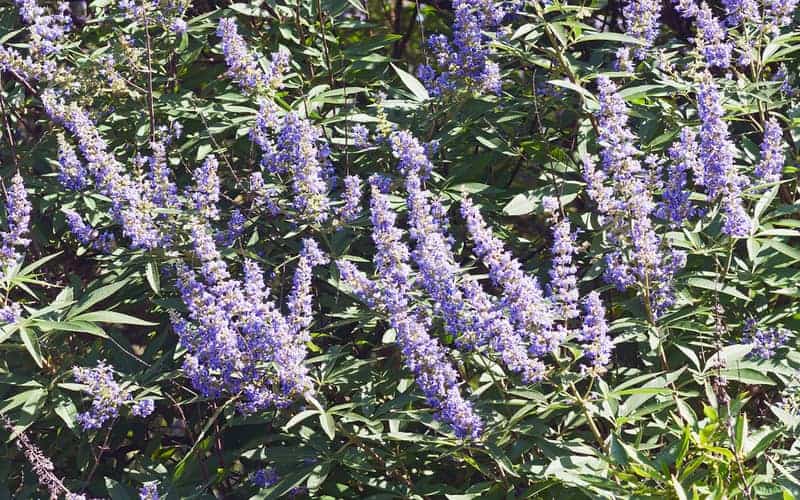
Size: 2–5m tall and 2–4m wide
Flowering season: Late spring to summer
Climate: Temperate to subtropical
The chaste tree (Vitex agnus-castus) is best known for its dark-coloured berries that were traditionally used as a spice.
Beyond this, the chaste tree is also popular for its ornamental value.
Plant it in full sun and it’ll produce tall spikes of fragrant flowers in late spring to summer.
The flowers are usually purple or violet-blue, standing out against grey-green foliage. They attract bees, butterflies, and other pollinators.
Chaste trees are easygoing. They thrive in most soil types and tolerate drought, frost, and even coastal winds.
Jacaranda
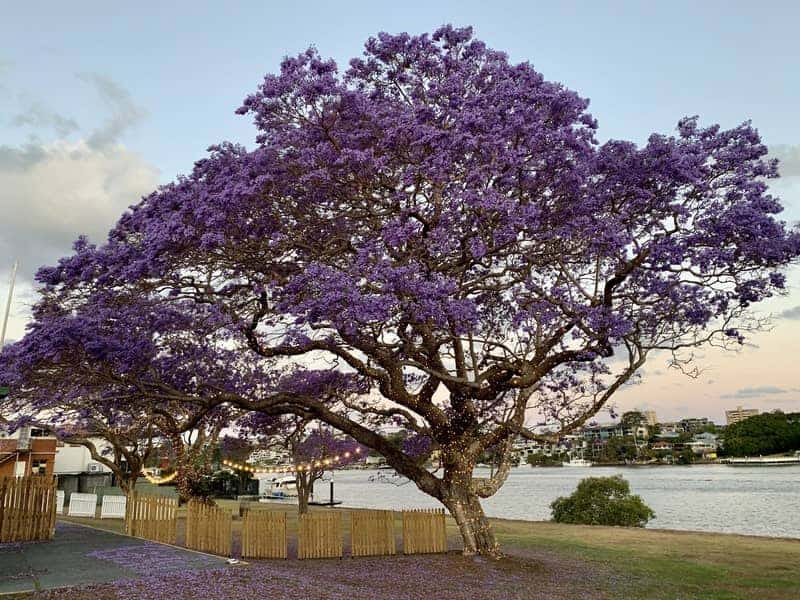
Size: 7–15m tall and 4–9m wide
Flowering season: Late spring to summer
Climate: Warm temperate, subtropical, and tropical
The jacaranda (Jacaranda mimosifolia) is arguably the most iconic purple flowering tree in Australia.
In late October to November, many flock to Grafton, NSW, to witness the Jacaranda Festival.
When in full bloom, the jacaranda’s bare branches are draped in masses of trumpet-shaped, lavender-blue flowers.
Although the jacaranda is widely loved, it’s considered invasive in some parts of Australia.
This fast-growing tree can escape cultivation and outcompete native species.
Be sure to check your local state or council regulations before planting a jacaranda!
Magnolia ‘Royal Purple’
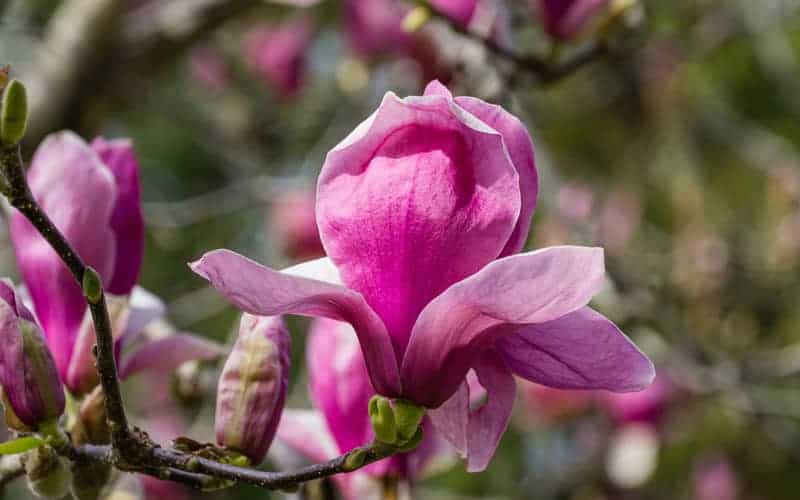
Size: 4-6m tall and 1-2m wide
Flowering season: Late winter to spring
Climate: Temperate
The magnolia ‘Royal Purple’ (Magnolia × soulangeana) is a flowering deciduous tree.
Its deep green foliage turns golden in autumn before dropping, leaving behind sculptural bare branches in winter.
By late winter or early spring, the tree bursts into large, cup-shaped, purple flowers. They’re lightly fragrant, too!
The ‘Royal Purple’ grows upright and slender. It’s a great choice for small gardens or large pots.
It does best in temperate regions like TAS, VIC, and parts of NSW.
Just plant it somewhere sheltered from strong winds, as its branches are quite brittle.
Tibouchina ‘Alstonville’
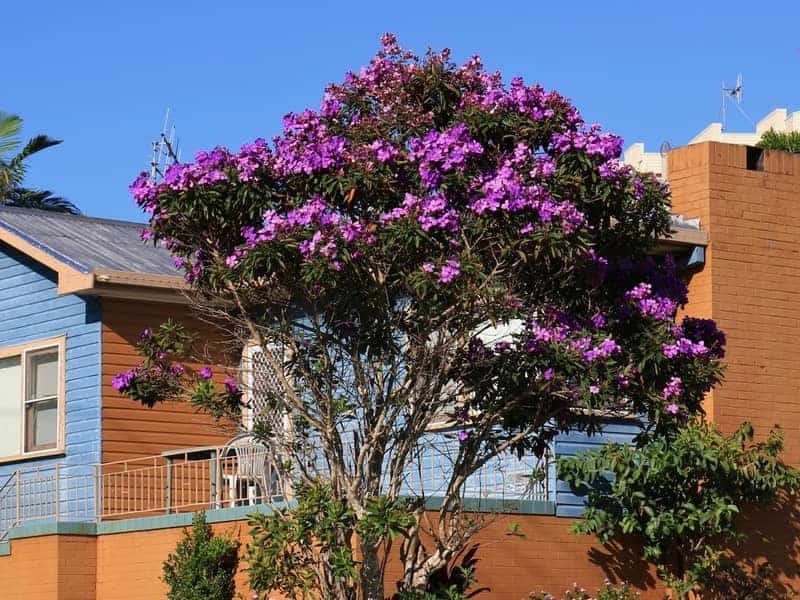
Size: 3–5m tall and 2–4m wide
Flowering season: Year-round
Climate: Subtropical to warm
If you’re after a tree that flowers for most of the year, try the tibouchina ‘Alstonville!’
The parent plant, Tibouchina lepidota, hails from South America.
However, the ‘Alstonville’ was developed here in Australia — specifically in Alstonville, NSW.
This evergreen tree puts on a long floral show from autumn through winter, often lasting well into spring.
Vivid purple, saucer-shaped blooms appear in masses, covering almost the entire tree.
The ‘Alstonville’ is not a fiddly plant to grow, but keep in mind that it doesn’t cope well with heavy frost.
It’ll be happy in warm climates, full sun, and well-drained, slightly acidic soil.
Trees with Red Flowers
Red flowers are bold and hard to miss — perfect for adding energy to your space.
For a fiery blaze in the garden, there’s a range of Australian red flowering trees to choose from.
Popular options include the Christmas bush, Illawarra flame tree, Queensland tree waratah, and the red flowering gum.
Christmas bush
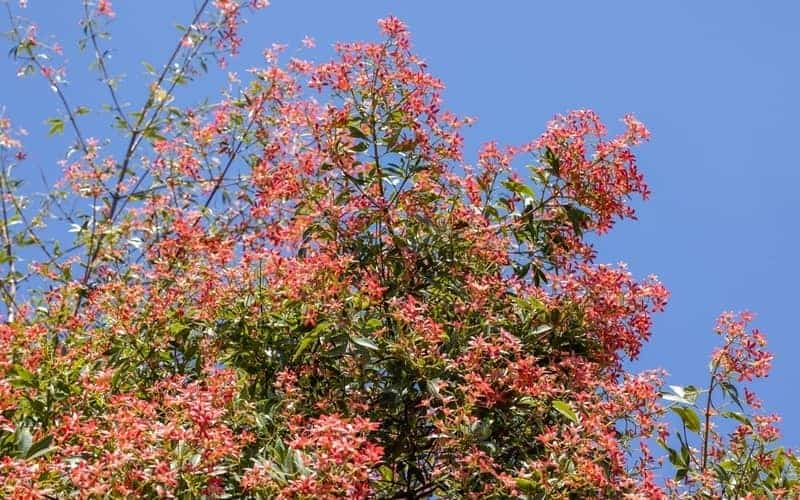
Size: 3–6m tall and 2–3m wide
Flowering season: Spring to summer
Climate: Warm temperate to subtropical
With the Christmas bush (Ceratopetalum gummiferum), you’ll experience a truly Aussie Christmas!
This native evergreen hails from NSW. It usually grows into a tall shrub or a small specimen tree.
It’s unique because the bright red flowers that everyone notices aren’t the true flowers.
In late spring, the Christmas bush produces small, creamy-white flowers that are easy to overlook.
When it’s done blooming, the bracts (or modified leaves) enclosing the flower bud enlarge and turn red.
The red “flowers” usually appear from spring to mid-summer, though they can show up earlier in warmer climates.
The blooms make excellent cut flowers, perfect for displaying inside your home during Christmas.
Illawarra flame tree
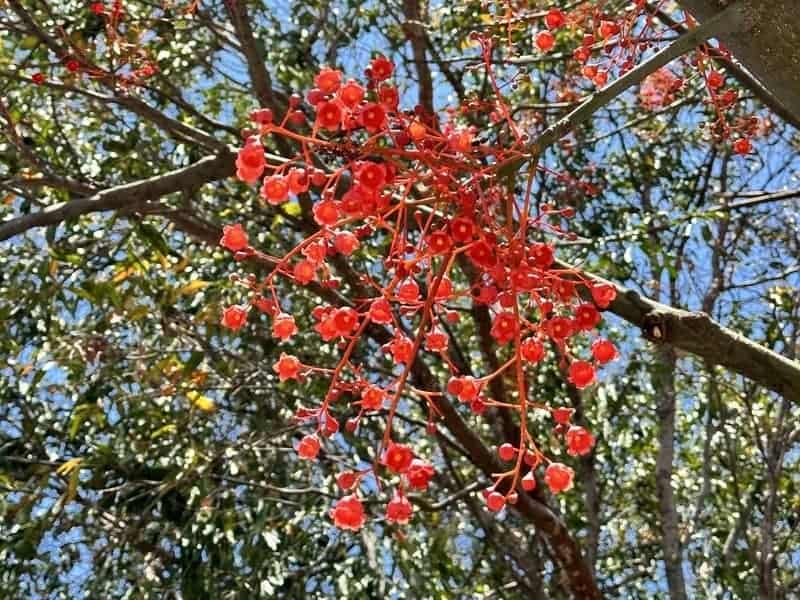
Size: 10–20m tall and 5–15m wide
Flowering season: Late spring to summer
Climate: Cool or warm temperate, Mediterranean, and subtropical
For an Aussie native feature plant that’ll turn heads, go for the Illawarra flame tree.
The Illawara flame tree — or Brachychiton acerifolius — is a tall (up to 20m!) tree with a broad canopy.
It’s deciduous, dropping its maple-like leaves just before it blooms.
Flowering usually happens in late spring to summer, though it can vary from year to year.
While it’s leafless, scarlet to fiery red, bell-shaped flowers appear in large bunches at the ends of the branches.
They cover the tree almost completely, making it look like it’s on fire!
The nectar-rich blooms attract many pollinators and birds, supporting a healthy ecosystem.
The Illawarra flame tree grows best in full sun. Like many Australian plants, it thrives in almost any well-draining soil.
Queensland tree waratah
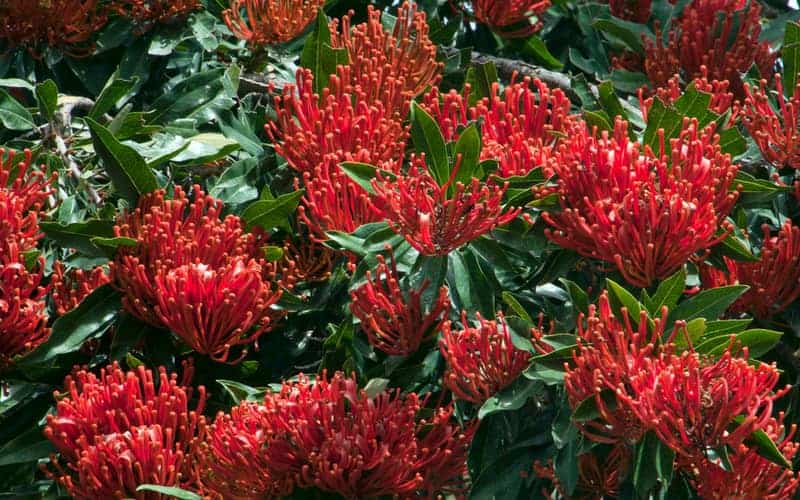
Size: 10m tall
Flowering season: Spring to early summer
Climate: Warm temperate, wet tropical, subtropical
The Queensland tree waratah (Alloxylon flammeum) is an evergreen tree from QLD’s rainforests.
It features oval, glossy, green leaves and a smooth, grey-brown bark. However, it’s the flowers that truly shine!
From August to November, it puts out long, bright red to orange-red flower clusters.
They’re often compared to spiders with their long styles (the central part of the flower).
The Queensland tree waratah is widely planted in gardens, parks, and streets. It grows best in warm temperate and tropical climates.
It’s not fussy with soil — just make sure drainage is excellent and phosphorus levels are low.
NOTE: This species isn’t the same as the NSW native waratah (Telopea speciosissima), though both are from the Proteaceae family.
Red flowering gum tree

Size: 10–15m tall and 5–10m wide
Flowering season: Summer to autumn
Climate: Temperate, subtropical
Nothing puts on a show quite like the red flowering gum tree (Corymbia ficifolia).
Originally from WA, it’s one of the most widely grown eucalypts, not only in Australia but worldwide!
From summer to spring, it produces large, bright red flower clusters called “corymbs” at the ends of the branches.
The blooms are made up of long stamens, which create a brush-like appearance.
These flowers are so dense and abundant, they can completely hide the foliage!
Even when the tree isn’t in bloom, it still makes an impression with its dense and rounded canopy.
Popular red flowering gum cultivars include:
- ‘Wildfire’: a top choice for streets and yards; grows up to 6m
- ‘Summer Red’: Bred to adapt to humid conditions; grows up to 6m
- ‘Mini Red’ and ‘Baby Scarlet’: small and rounded, growing up to 2.5–3m
While flowering gums love a warm climate, they can grow almost anywhere in Australia. Just be sure to protect young trees from frost.
Trees with White Flowers
If you’re unsure what colour works for your space, go for a white flowering tree.
Magnolias are a classic, but don’t overlook flowering dogwoods and native options like ivory curl and lemon myrtle.
Flowering dogwood
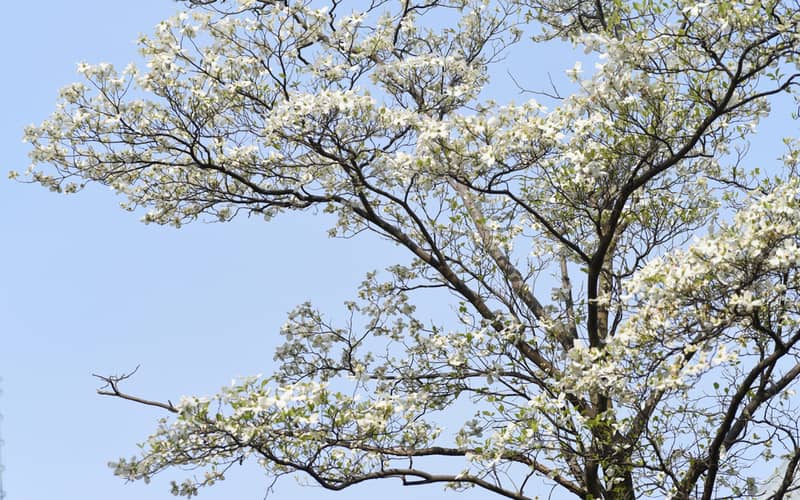
Size: 5–10m tall and wide
Flowering season: Spring to summer
Climate: Cool temperate
The flowering dogwood (Cornus florida) is a small to medium-sized, deciduous tree suitable for the cooler parts of Australia.
In early to mid-spring, it puts on a spectacular display — it almost looks like the tree is covered in snow!
White, four-petaled flowers grow on the bare branches, surrounding tiny florets in the centre.
After blooming, the tree grows dark green, oval leaves, which turn red or purple in autumn.
In winter, the flowering dogwood drops its leaves and reveals horizontal branches with an elegant silhouette.
Ivory curl tree
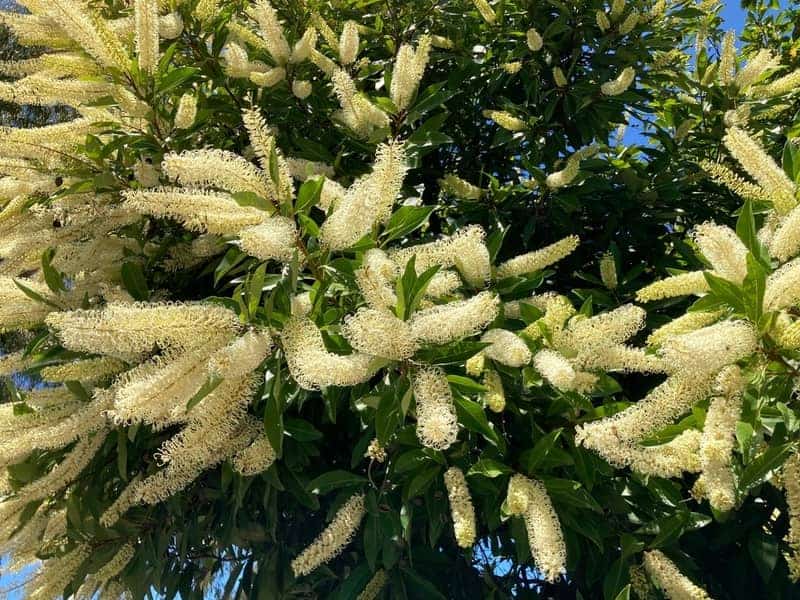
Size: 5–10m tall and 4–6m wide
Flowering season: Late spring to autumn
Climate: Subtropical to warm temperate
If you’re after a native statement piece, the ivory curl tree (Buckinghamia celsissima) is a top pick!
This ornamental tree came from northeastern QLD, but it can thrive in any warm climate in Australia.
It’s cherished for its long, cascading flower spikes (or racemes), which are creamy-white to ivory.
They appear in large bunches and cover much of the tree from late spring to autumn.
The flowers are nectar-rich, attracting helpful insects and pollinators.
Moreover, the ivory curl makes an excellent shade tree with its evergreen, dense foliage.
It’s also hardy, which makes it suitable for street planting.
Lemon myrtle
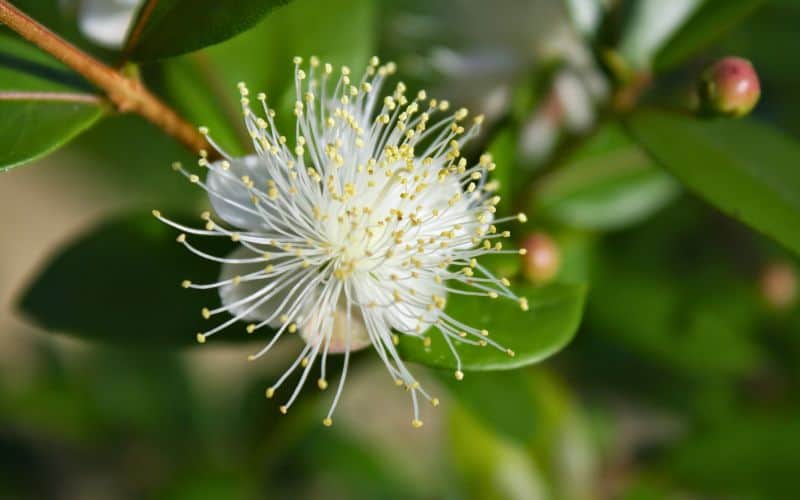
Size: 4–6m tall and 2–4m wide
Flowering season: Summer to autumn
Climate: Subtropical and warm temperate
The lemon myrtle (Backhousia citriodora) is an Australian native tree from the subtropical areas in NSW and QLD.
It’s a slow-growing plant that develops into a hedge or a small feature tree.
In summer to autumn, creamy-white, fluffy flowers emerge in clusters, attracting butterflies and bees.
The blooms have a feathery, tufted appearance with long stamens that fan out from the centre.
Meanwhile, the leaves are popular for their citrusy scent, which is why they’re often used in food and drinks.
Lemon myrtle prefers warmer climates. However, it can still grow in colder areas if protected from frost while young.
Magnolia tree
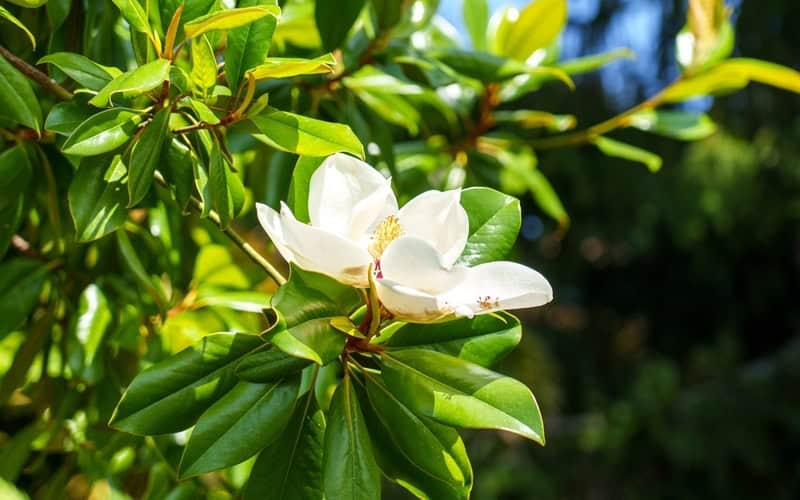
Size: 10–20m tall and 8–10 m wide
Flowering season: Late winter to spring
Climate: Warm temperate to subtropical
The evergreen magnolia (Magnolia grandiflora) makes a bold statement in any garden.
It’s famous for its gigantic, creamy-white flowers, about 20–30 cm wide.
They’re not just visually captivating! The flowers boast a powerful, sweet scent that you can smell from a distance.
While the individual blooms don’t last long, the tree consistently puts out new ones.
Flowering usually starts in late winter or spring and continues through summer.
Magnolia trees are also massive. They grow up to 20m tall and 10m wide, so they’re best for large spaces.
For compact gardens, there are dwarf types available, like the ‘Little Gem’ and ‘Teddy Bear.’
These trees prefer a loamy, well-drained, and slightly acidic soil. They love a warm climate but can handle a bit of frost once mature.
Trees with Yellow Flowers
Nothing can brighten your garden quite like yellow flowers.
In Australia, the most iconic yellow flowering tree is the golden wattle, our national floral emblem.
Other great picks include the golden penda, native frangipani, and the yellow kapok.
Golden penda
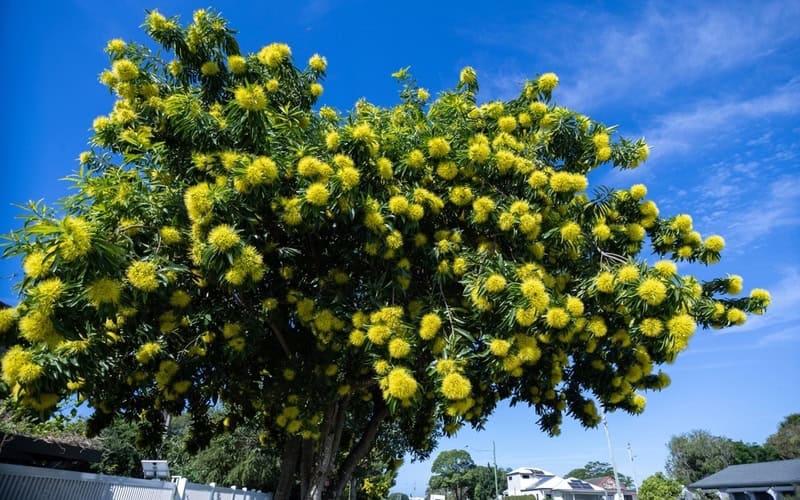
Size: 6–10m and 4–6m wide
Flowering season: Summer and autumn
Climate: Subtropical and warm temperate
Golden penda (Xanthostemon chrysanthus) is an evergreen Australian native that originated in QLD.
In late summer and autumn, the tree is covered with a profusion of bright, golden-yellow flowers.
They have several prominent stamens, so they look feathery!
The “xanthos” in the botanical name, Xanthostemon, actually means “yellow thread” or “yellow stamen.”
Moreover, the golden penda is a fast-growing tree. It quickly develops into a lush shade tree with a dense canopy.
Alternatively, you can plant golden pendas in a row and prune them to a smaller size to create a dense hedge.
X. chrysanthus prefers a sunny position and rich, well-draining soil.
Once mature, it’s hardy and can handle drought, humidity, and salty environments.
Golden wattle
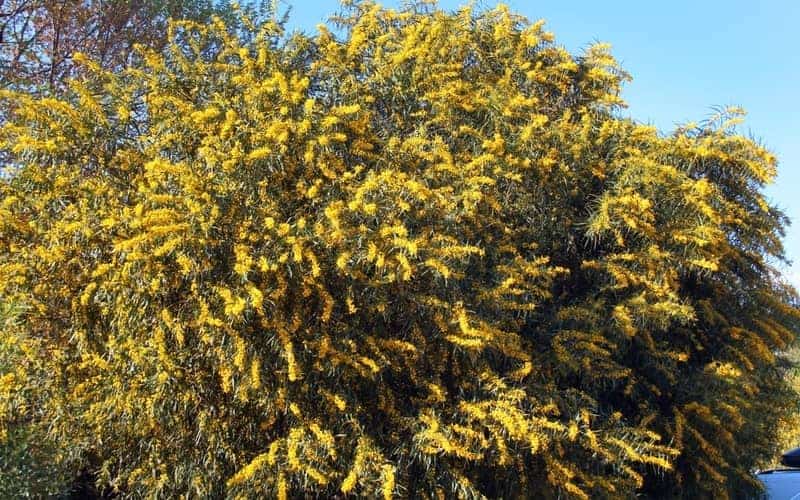
Size: 4–8m tall and 3–6m wide
Flowering season: Late winter to spring
Climate: Temperate
For a truly iconic feature, why not grow the golden wattle?
Botanically known as Acacia pycnantha, the golden wattle is Australia’s floral emblem.
It grows quickly into a large shrub or medium-sized tree, adding 1–2m in height per year.
But what truly steals the show are the flowers. The golden wattle brightens gardens from late winter to spring.
Spherical, fluffy flower heads grow in elongated clusters along the branches. Each “flower ball” is made up of 40–80 individual florets!
The blossoms also have a floral, slightly sweet scent, often used to make perfumes.
One caveat, though, is that wattle trees are short-lived, usually lasting about 12–15 years.
Still, they’re adaptable. They thrive in any well-draining soil and can tolerate some drought and frost.
NOTE: The golden wattle may be considered invasive in certain regions, so check local regulations before planting!
Native frangipani

Size: 10–12m tall and 3–6m wide
Flowering season: Late spring to summer
Climate: Subtropical, Mediterranean, and warm temperate
Despite its name, the native frangipani (Hymenosporum flavum) isn’t a true frangipani — but it’s just as stunning.
It grows upright with glossy evergreen leaves, making it a popular feature tree in warm regions.
This Australian flower is also loved for its fragrant, trumpet-shaped blooms.
They start out pale cream and deepen to rich yellow as they age.
The flowers’ sweet scent is strongest in the evening and draws in birds, bees, and other pollinators.
The native frangipani thrives in full sun or part shade and can tolerate dry spells once established.
Yellow kapok
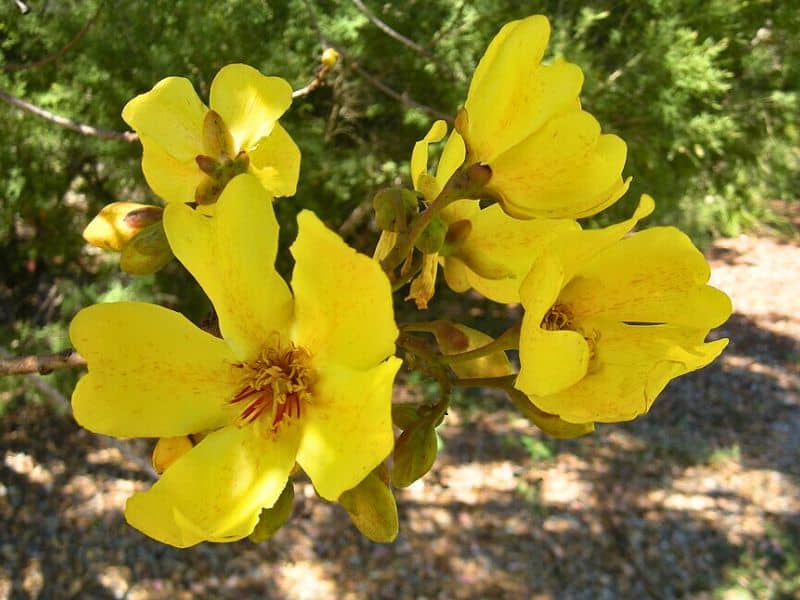
Size: 4–6m tall and wide
Flowering season: Dry season (May to October)
Climate: Monsoon or dry tropical
The yellow kapok (Cochlospermum fraseri) is a native tree that can be found in the NT, QLD, and parts of WA.
This deciduous tree sheds its leaves in the dry season to conserve water, making it ideal for waterwise gardens.
While the branches are bare, it produces star-shaped, yellow flowers. It provides a stunning display when other plants aren’t blooming!
The yellow kapok isn’t just ornamental — it’s also prized for its many uses.
The blooms are edible and can be enjoyed raw or cooked.
If left on the tree, they turn into pods that contain “kapok” — a cotton-like material used to stuff pillows and cushions.
Moreover, the yellow kapok’s bark can be fashioned into strings and paintbrushes.
The yellow kapok prefers a climate with distinct wet and dry seasons. It grows well in gravelly, loamy, or sandy soils, but won’t tolerate being waterlogged.
Flowering Trees with Different Colours
Whether you’re drawn to soft pastels or bold hues, there’s a flowering tree you’ll love!
Banksias, crepe myrtles, frangipanis, and flowering gums can bloom in a range of colours, depending on the variety.
Banksia
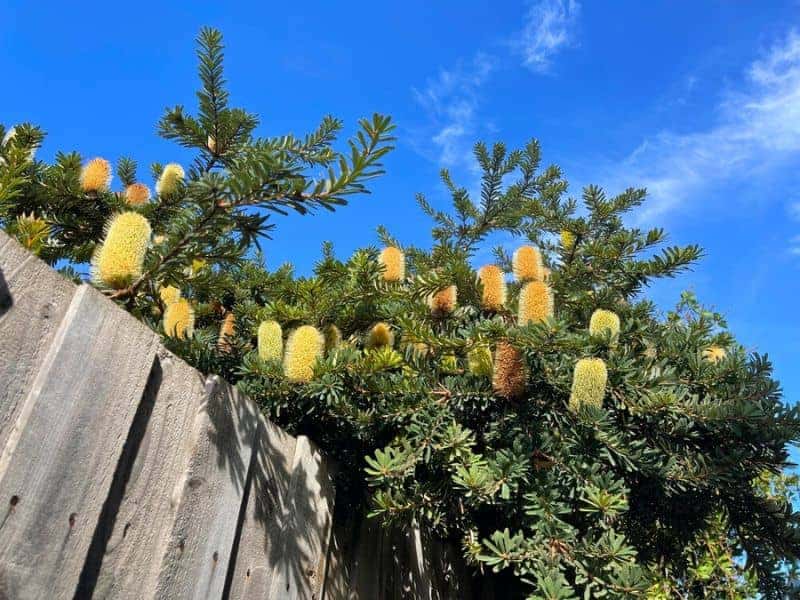
Size: Varies; 1m–25m tall
Flowering season: Varies; usually autumn to winter
Climate: Warm temperate to subtropical
Banksia is a fascinating genus with around 170 species, and all but one are native to Australia!
Growing as small trees or shrubs, they’re known for distinct, brush-like flowers that come in different colours.
- BROWN: Hairpin banksia (B. spinulosa)
- GREEN: Fern-leaf banksia (B. oblongifolia)
- ORANGE: Acorn banksia (B. prionotes) and orange glow banksia (B. ericifolia)
- RED: Red beacon banksia (B. occidentalis) and scarlet banksia (B. coccinea)
- YELLOW: Coast banksia (B. integrifolia) and saw banksia (B. serrata)
The flowering season varies by species, but many bloom in autumn and winter.
Banksias are vital to Australian ecosystems, producing nectar that native wildlife love to feed on.
Crepe myrtle
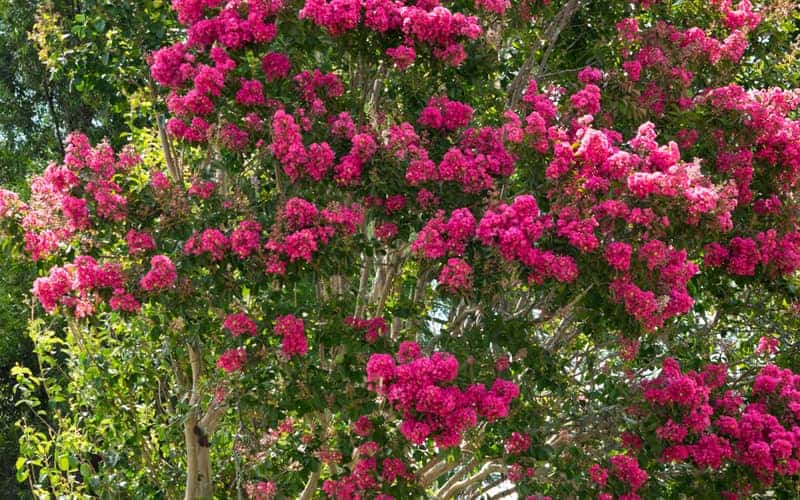
Size: 4m tall and 3m wide
Flowering season: Summer to autumn
Climate: Warm temperate to subtropical
Crepe myrtles (Lagerstroemia indica) are deciduous trees admired for being one of the longest-blooming plants.
From late spring to autumn, crepe myrtles produce different flower colours, depending on the variety.
- PINK: ‘Biloxi,’ ‘Sioux,’ and ‘Tuscarora’
- PURPLE: ‘Muskogee,’ ‘Purely Purple,’ and ‘Zuni’
- RED: ‘Red Rocket’ and ‘Ruffled Red Magic’
- WHITE: ‘Acoma,’ ‘Albury White,’ and ‘Natchez’
The flowers have crinkled petals that resemble crepe paper, giving them a soft, delicate beauty.
Crepe myrtles also feature a dense canopy of dark green leaves.
In autumn, they transform into shades of orange, red, yellow, or purplish-red before falling in winter.
L. indica can handle a bit of drought and frost once established. They prefer a sunny position and well-draining, slightly acidic soil.
Flowering gum trees

Size: 10–15m tall and 5–10m wide
Flowering season: Summer to autumn
Climate: Temperate or Mediterranean
The flowering gum tree (C. ficifolia) is perhaps most famous for its fiery red blooms.
However, different varieties offer many flower colours!
- ORANGE: ‘Baby Orange,’ ‘Dwarf Orange,’ and ‘Orange Splendour’
- PINK: ‘Calypso Queen,’ ‘Fairy Floss,’ and ‘Summer Beauty’
- WHITE: ‘Snowflake,’ ‘Summer Snow,’ and ‘White Heaven’
Like the red flowering cultivars, these offer a magnificent display, with fuzzy flowers appearing in large clusters.
Flowering gum trees thrive in full sun and well-drained soil.
Once established, they can tolerate drought, salty conditions, and even air pollution.
Frangipani
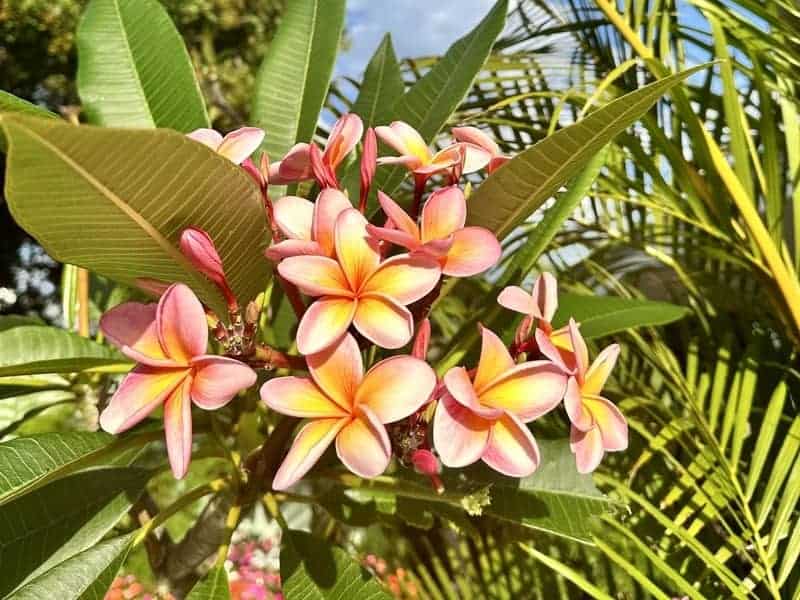
Size: 2–8m tall and wide
Flowering season: Summer to autumn
Climate: Warm, tropical, and subtropical climates
While Australia has its native frangipani (H. flavum), it’s unrelated to the common frangipani (Plumeria)!
The common frangipani is an iconic, tropical plant. It can grow just about anywhere without frost.
In Australia, you’ll find lots of pretty frangipani trees offering a wide range of hues.
- PINK: ‘Pink Sunrise,’ ‘Candy Rainbow,’ and ‘Petite Pink’
- RED: ‘Pure Red,’ ‘Hilo Beauty,’ and ‘Japanese Lantern’
- WHITE: ‘Common White,’ ‘Singapore White,’ and ‘Petite White’
- YELLOW: ‘Aztec Gold,’ ‘Bowen Yellow,’ and ‘Buttercup’
- MULTI-COLOURED: ‘Fruit Salad,’ ‘Cotton Candy,’ and ‘Cooktown Sunset’
Frangipani trees are also famous for their lovely, sweet fragrance that smells strongest in the evenings.
Some frangipanis are deciduous, but can be evergreen in warmer climates.
As tropical trees, they need plenty of sun and can be sensitive to cold temperatures below 10°C.
What to Keep in Mind When Growing Flowering Trees
Most flowering trees need full sun to bloom well, so plant them in a bright, open spot.
Some species can also grow quite tall or wide. It’s worth booking a professional pruning service to keep your tree in shape.
Before planting, check if the tree is suited to your local climate to make sure it’ll thrive and flower successfully.
Lastly, don’t forget to consider your local ecosystem!
Some trees can become invasive, so always check local guidelines before planting any type of tree.
FAQs About Flowering Trees in Australia
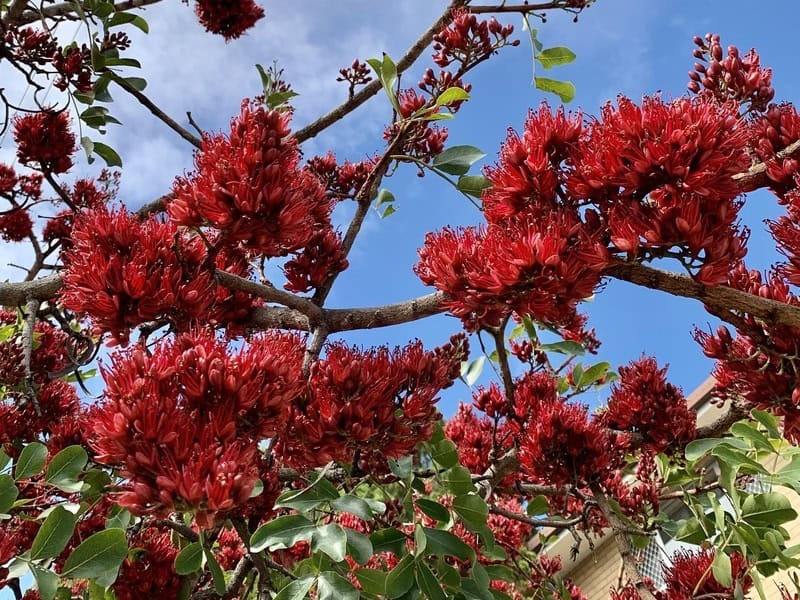
Got more questions? Here’s what you must know if you want to grow a flowering tree!
What are the largest flowering trees in Australia?
Among the ones we listed in this article, the largest flowering trees are:
- Flowering gum and jacaranda: Can reach 15m tall
- Illawarra flame tree: Can reach up to 20m tall
- Yellow kapok: Can grow to 20m in warm climates
What flowering tree stays in bloom the longest?
For trees that flower year-round in Australia, consider the crepe myrtle, golden penda, and Tibouchina ‘Alstonville.’
These trees may not bloom every single month, but their long floral display spans several seasons.
In warm climates, they can also flower randomly throughout the year!
What are the best flowering trees for every season?
If you’re looking for a tree that blooms at specific seasons, here are our top picks:
SUMMER FLOWERING TREES: Crepe myrtle, common frangipani, Illawarra flame tree
AUTUMN FLOWERING TREES: Tibouchina ‘Alstonville’, ivory curl
WINTER FLOWERING TREES: Magnolia, golden wattle, banksia
SPRING FLOWERING TREES: Blueberry ash, cherry blossom, Christmas bush
Just keep in mind that flowering times can vary depending on the local climate and growing conditions.
What flowering trees are best for my area?
Ideally, choose flowering trees that are native to your region. Those are suited to the local climate and will thrive best.
That said, here are some options that tend to do well in major Australian cities:
ADELAIDE: Cherry blossom, eastern redbud, Illawarra flame tree, magnolia
BRISBANE: Frangipani, golden penda, Illawarra flame tree, tibouchina ‘Alstonville’
CANBERRA: Cherry blossom, eastern redbud, flowering dogwood, magnolia
GEELONG: Cherry blossom, eastern redbud, flowering gum, native frangipani
MELBOURNE: Cherry blossom, flowering dogwood, flowering gum
PERTH: Banksia, frangipani, flowering gum, Illawarra flame tree, magnolia
SYDNEY: Blueberry ash, cape chestnut, Christmas bush, ivory curl, tibouchina ‘Alstonville’
Some trees, like the chaste tree, crepe myrtle, and magnolia, can grow in nearly any climate.
Just note that how long, how much, and when they bloom can vary depending on their growing conditions.

